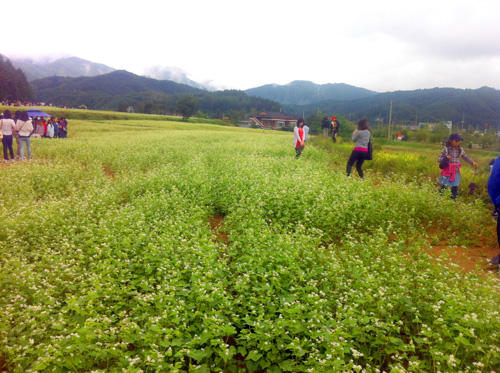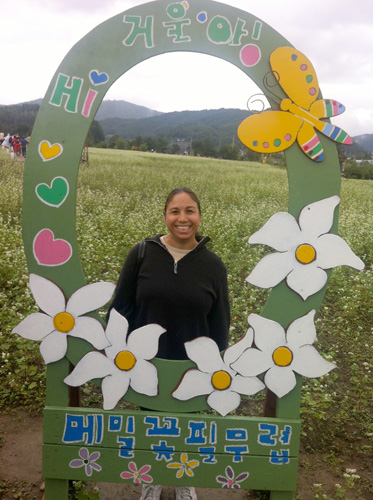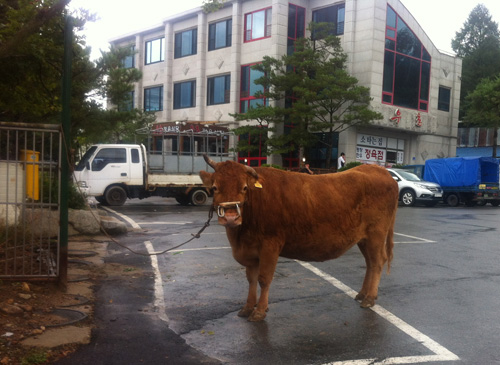The Lee Hyoseok Buckwheat Festival (named after his super famous in Korea short story “When Buckwheat Blossoms Bloom”) was on this weekend, so the wife and I decamped.
The bus ride down was uneventful and only took two hours, thankfully a full half-hour shorter than the guidebooks said. We got to Jangpyeong (the nearest town with an intercity bus station) and found a hotel that was basically right across the street from the train station. There is also another hotel on the main street, on the edge of town. From the outside it appeared more modern, but we had already got a room, so we were set. When our attempts to order a pizza without phoning the order in were rebuffed, we went to the Discount Mart and got crackers and cheese. Yvonne got a vat of some kind of hideous meat-product, and proceeded, with several crackers, to demolish the thing. This was very good for me, since the stuff smelled like rotten monkey-parts (or what I imagine they would smell like). While we shopped for this stuff a woman near the register began chatting us up, and introduced us to two young girls who, she said, would be serving as hospitality guides at the festival the next day. We laughed and promised to look for them.
In the morning it was a quick cab ride (about 8 chun, as the rates are a bit higher) to the festival. This, going down the day before approach seemed like a good one, as we didn’t waste 2.5 hours in the morning just getting there.If you are a morning person, maybe you can catch the early bus, but if not, head down the day before.
There are multiple ways in, but if you head in from the main strip of Bongpyeon you go through a long alley of pochang-type stalls, selling food, shoes, and other assorted things. I took one picture of my wife standing by the entrance and in protest my camera committed suicide! Consequently all the photos here are from my iPhone.
Walk through the parking lot and you have the choice of two semin-natural bridges, one all of stones, the other occasionally bridged by multiple lengths of thin tree trunks. For the less adventurous, there is also a fully modern bridge to the left.
Across the bridge you trek over some wood paths – narrow when there are multitudes of people, past a couple of pens with sheep and donkeys. Then one more bridge, constructed of wood, evergreen boughs and a layer of clay. Walking on this felt really weird, because the bridge moves, and the clay/bough construction also gives substantially under your feet.
Then it is up some stairs to a raised wood walkway to the left that meanders through the fields of buckwheat (pretty impressive in bloom) and past a variety of goofy photo opportunities with decorated chairs, benches, and cutouts of various kinds. You can follow this to the left until it peters out, and then loop back, up against the back of the park, past several restaurants and back towards the front of the park.. I will say that the sight of the buckwheat fields against the local hills is quite impressive.
Then it is back down to the road, and the pathway that leads up a short but often sharp trail (this is to the far left of the park, as you look at the park from the entrance). This path leads up to the munhakwan, which charges a nominal fee (2 chun and lower) for entrance. There is also a funky little teahouse where 3 chun buys you a glass of maemil tea. One wall is covered in books, all of which are in Korean.
The museum is kind of cool, although only one little bit is in English and don’t expect the staff to have any English at all (also, no photos for foreigners, though I did see several Korean women taking shots). The museum begins with Lee Hyoseok’s history and literature, and as you work your way around it counter-clockwise you soon enter a section on the history and uses of buckwheat (food, fabric, pillow-stuffing). It’s kind of cool, particularly the photo-essay on how buckwheat jelly (more like Jello, actually) is made – buckwheat jelly is a pretty regular form of banchan on tables around Korea, and I had no idea it was made of buckwheat.
Above the teahouse and museum there is a trail that runs the upper edge of the park and in a lovely little grass glen, there is another trail that runs through some beautiful woods, above the back of the park and off to god knows where. As it had just rained, the woods were overflowing with mushrooms and various kinds of fungi, but strangely not one ajumma could be seen picking them.
Back down to the front of the park and over the ‘real’ bridge and you come to the entertainment and food section of the festival. There were about 8 booths selling 8 versions of things buckwheat. I can say that the buckwheat makkeolli tasted just the same as any other makkeolli, but the buckwheat bread is quite good. The entertainment was festival-typical, including drumming, dancing, and singing. The entertainment is right adjacent to Gasan Park, which is a small square of greenery in the middle of town, and the main drag is not so many blocks away.
Then we walked to the edge of town in search of some non-buckwheat late-lunch. At the very edge of town the BBQ’s hung out in exile, clustered against their more popular buckwheat-based restaurants.
A look at Naver maps the day before had shown a couple of pensions out beyond the restaurants, and so, with dinner destination set, we wandered out a country road about 200 yards before seeing about 6 signs advertising pensions to the left, and off we went, across a bridge and to the first pensions. One was up on a hill and looked pricey. The other was by a river, four little abutting cottages, and it was only 80 chun a night. There was only one room with a bed, which Yvonne wanted, but it was not ready. So, we left our stuff and wandered back and had dinner at a restaurant that had a very live and very big cow tethered in front of it.
This lucky cow is the restaurant’s mascot and we later saw him being driven somewhere in the bed of a pickup truck
The pension was totally awesome and one of the proprietors 으나 speaks brilliant English. So when you look at this website: http://www.mdarae.com/ and only see Korean, don’t freak out… give them a call or send an email. You probably wouldn’t want to stay here in summer as it is electric-fan only, but in temperate weather it is great, and within easy walking distance of the fairly small “downtown” of the town.
Late-lunch was good, and we went back to the pension to wait for evening. At about 4:30 we headed out back to the entertainment/food area, and as we sat there, lo and behold, the two girls from the night before came up to us and offered to take us sight-seeing. Turns out they were 15 year-old best friends, and after the initial bouts of shy giggling (pretty funny, considering they rousted us) they turned out to be really good guides and happy to practice their English and let me practice my Korean. They wandered us around and showed us things like a replica of Lee’s house, and tried to buy my wife a cotton candy!
The next day we talked to the nice people at the pension, then walked into town for some coffee and buckwheat bread.
It took a second to catch a taxi, and we got to the Jangpyeong Terminal about 20 minutes before the next bus. Happily, there were seats available (one weird thing about inter-city buses is that you have to buy your tickets on the day) and we were off to Seoul.
All in all a great experience in a wonderful place, and lots of relics/exhibits related to Lee Hyosek, When Buckwheat Blossoms Bloom, and Buckwheat in general.
Getting There
Dong Seoul Bus Terminal (Gangbyeon Station, Subway Line 2). Most online sources say this takes 2.5 hours, but the route seems to have changed and it only took 2 hours, both ways.
Take an intercity bus to Jangpyeong Intercity Bus Terminal (Gangwon-do).
From the terminal take a city bus or taxi to Bongpyeong.








